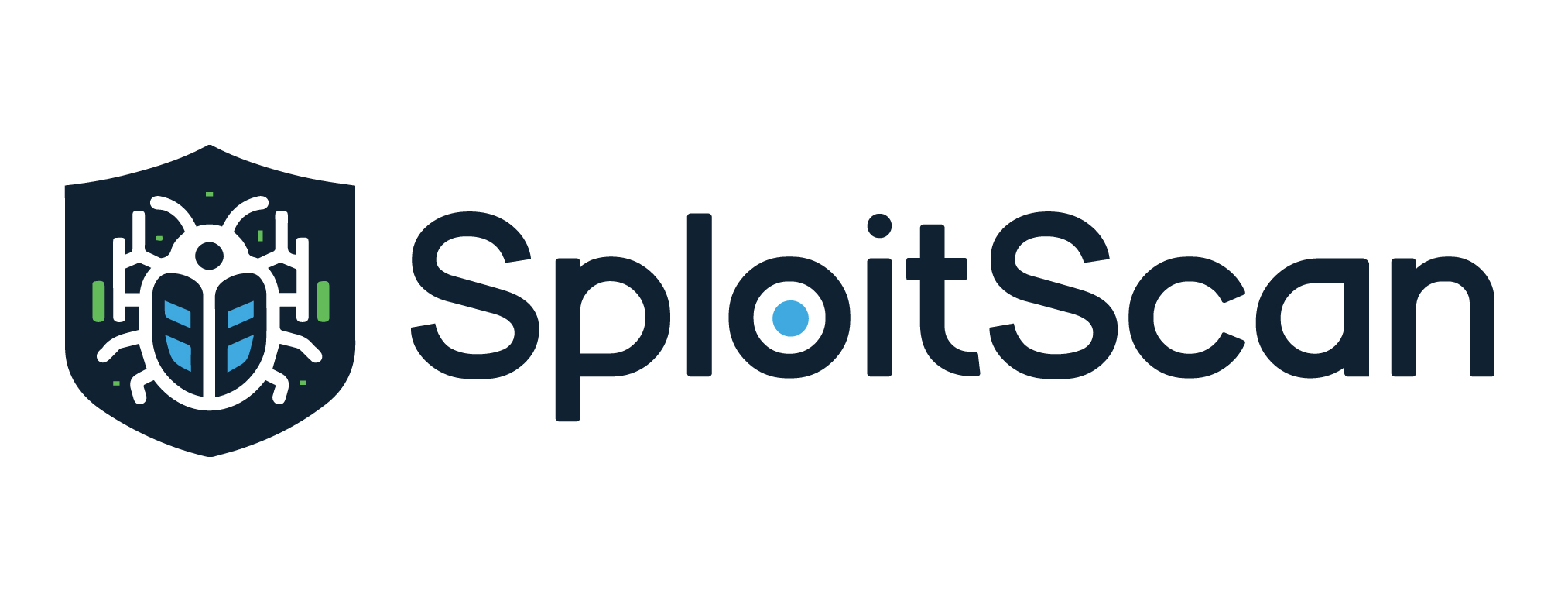
SploitScan は、既知の脆弱性の悪用とそれぞれの悪用の可能性を特定するプロセスを合理化するように設計された強力で使いやすいツールです。既知のエクスプロイトを迅速に特定して適用し、テストできる機能をサイバーセキュリティ専門家に提供します。これは、セキュリティ対策を強化したり、新たな脅威に対する堅牢な検出戦略を開発しようとしている専門家にとって特に価値があります。
説明
特徴
サポートされているエクスプロイト データベース
サポートされている脆弱性スキャナーのインポート
インストール
使用法
AI を活用したリスク評価
パッチ優先システム
貢献する
著者
変更履歴
参考文献
CVE 情報の取得: National Vulnerability Database から CVE の詳細を取得します。
EPSS 統合: Exploit Prediction Scoring System (EPSS) データが含まれており、CVE 悪用の可能性の確率スコアを提供し、優先順位付けを支援します。
Public Exploits Aggregation : 公開されているエクスプロイトを収集し、脆弱性への理解を深めます。
CISA KEV : CVE が CISA の既知の悪用された脆弱性 (KEV) にリストされているかどうかを示します。
AI を活用したリスク評価: OpenAI を活用して、詳細なリスク評価、潜在的な攻撃シナリオ、緩和策の推奨事項、および概要を提供します。
HackerOne Reports : CVE が HackerOne Bug Bounty プログラム内で使用されたかどうかを、全体的なランクと重大度の分布を含めて表示します。
パッチ優先順位システム: 公開エクスプロイトの可用性などのさまざまな要因に基づいて、パッチ適用の優先順位を評価し、割り当てます。
マルチ CVE のサポートとエクスポート オプション: 1 回の実行で複数の CVE をサポートし、結果を HTML、JSON、CSV 形式にエクスポートできます。
脆弱性スキャナーのインポート: 一般的な脆弱性スキャナーから脆弱性スキャンをインポートし、既知のエクスプロイトを直接検索します。
詳細なメソッド選択: 特定のメソッド (例: cisa 、 epss 、 hackerone 、 aiなど) のみを使用して、取得するデータを制御できます。
ユーザーフレンドリーなインターフェイス: 使いやすく、明確で簡潔な情報を提供します。
包括的なセキュリティ ツール: 迅速なセキュリティ評価と、最近の脆弱性に関する情報の入手に最適です。
GitHub
ExploitDB
VulnCheck (無料のVulnCheck API キーが必要)
パケットストーム
核
ネッスス (.nessus)
Nexpose (.xml)
OpenVAS (.xml)
ドッカー (.json)
git clone https://github.com/xaitax/SploitScan.gitcd sploitscan pip install -r 要件.txt
pip install --user sploitscan
sploitscan を適切にインストールする
VulnCheck : VulnCheck で無料アカウントにサインアップして、API キーを取得します。
OpenAI : OpenAI でアカウントを作成し、API キーを取得します。
注: OpenAI および VulnCheck API キーはオプションです。 OpenAI API キーは AI を活用したリスク評価に使用され、VulnCheck API キーは VulnCheck データの取得に使用されます。これらの機能を使用しない場合は、構成ファイルを省略するか、API キーのフィールドを空白のままにすることができます。
API キーを使用して、次のいずれかの場所にconfig.jsonファイルを作成します。
現在のディレクトリ
~/.sploitscan/
~/.config/sploitscan/
/etc/sploitscan/
~/Library/Application Support/sploitscan/ (macOS)
%APPDATA%/sploitscan/ (Windows)
--configまたは-cコマンドライン引数を使用して、カスタム構成ファイルのパスを指定することもできます。
{ "vulncheck_api_key": "your_vulncheck_api_key"、"openai_api_key": "your_openai_api_key"}$ sploitscan.py -h ███████╗██████╗ ██╗ ██████╗ ██╗████████╗███████╗ █████ █╗ █████╗ ███╗ ██╗ ██╔════╝██╔══██╗██║ ██╔═══██╗██║╚══██╔══╝██╔════╝██╔════╝██╔══██╗████╗ ██║ ███████╗██████╔╝██║ ██║ ██║██║ ██║ ███████╗██║ ███████║ ██╔██╗ ██║ ╚════██║██╔═══╝ ██║ ██║ ██║██║ ██║ ╚════██║██║ ██╔══██║██║╚██╗██║ ███████║██║ ███████╗╚██████╔╝██║ ██║ ███████║╚██████╗ ██║ ██║██║ ╚████║ ╚══════╝╚═╝ ╚══════╝ ╚═════╝ ╚═╝ ╚═╝ ╚══════╝ ╚═════╝╚═╝ ╚═╝╚═╝ ╚═══╝ v0.11.0 / Alexander Hagenah / @xaitax / [email protected] 使用法: sploitscan.py [-h] [-e {json,JSON,csv,CSV,html,HTML}] [-t {nessus,nexpose,openvas,docker}] [-m メソッド] [-i IMPORT_FILE] [ -c CONFIG] [-d] [cve_ids ...] SploitScan: 指定された CVE ID の脆弱性データと公開エクスプロイトを取得して表示します。 位置引数: cve_ids データをフェッチする 1 つ以上の CVE ID を入力します。複数の CVE ID はスペースで区切ります。各 ID の形式: CVE-YYYY-NNNNN。インポート ファイルが提供されている場合、この引数はオプションです -i オプションを使用します。 オプション: -h、--help このヘルプ メッセージを表示して終了します -e {json,JSON,csv,CSV,html,HTML}, --export {json,JSON,csv,CSV,html,HTML} オプション: 結果を JSON、CSV、または HTML ファイルにエクスポートします。形式を指定します:「json」、「csv」、または「html」。 -t {nessus,nexpose,openvas,docker}, --type {nessus,nexpose,openvas,docker} インポート ファイルのタイプを指定します: 'nessus'、'nexpose'、'openvas'、または 'docker'。 -m メソッド、--methods メソッド 実行するメソッドをカンマで区切って指定します。オプション: 「cisa」、「epss」、「hackerone」、「ai」、「prio」、「references」など。 -i IMPORT_FILE、--import-file IMPORT_FILE 脆弱性スキャナーからのインポート ファイルへのパス。 CVE ID を使用する場合は、コマンド ライン引数から CVE ID を省略できます。 -c 設定、--config 設定 カスタム構成ファイルへのパス。 -d, --debug デバッグ出力を有効にします。
sploitscan CVE-2024-1709
sploitscan CVE-2024-1709 CVE-2024-21413
タイプ: 'nessus'、'nexpose'、'openvas'、または 'docker' を指定し、ファイル パスを指定します。
sploitscan --import-file path/to/yourfile.nessus --type nessus
特定のデータ取得方法 (CISA、EPSS、AI リスク評価など) のみを実行するには、 -m引数を使用します。
sploitscan CVE-2024-1709 -m cisa、epss
エクスポート形式を「json」、「csv」、または「html」から指定します。
sploitscan CVE-2024-1709 -e html
Docker がインストールされていることを確認してください。インストール手順については、Docker の公式インストール ガイドを参照してください。
Docker で SploitScan を構築して実行するには:
docker build -t sploitscan .docker run --rm sploitscan CVE-2024-1709
現在のディレクトリからボリュームがマウントされている場合
docker run -v ${PWD}:/app --rm sploitscan CVE-2024-1709 -e JSONdocker run -v $(pwd):/app --rm sploitscan CVE-2024-1709 -e JSON
SploitScan は OpenAI と統合し、AI を活用した包括的なリスク評価を各 CVE に提供します。この機能には次のものが含まれます。
詳細なリスク評価: 脆弱性の性質とそのビジネスへの影響を理解します。
潜在的な攻撃シナリオ: 脆弱性を利用した潜在的な攻撃シナリオの説明を取得します。
軽減に関する推奨事項: リスクを軽減するための具体的で実行可能な推奨事項を受け取ります。
エグゼクティブ サマリー: 技術者以外の関係者でもアクセスできる、ビジネスへの影響と緊急性を強調した簡潔なサマリー。
$ sploitscan.py CVE-2024-21413
[...]
┌───[ ? AI-Powered Risk Assessment ]
|
| 1. Risk Assessment
| -------------------
| The vulnerability identified by CVE-2024-21413 is a critical remote code execution flaw in
| Microsoft Outlook with a CVSS score of 9.8. The impact on business operations can be severe due to
| its high potential to be exploited over a network without any user interactions or elevated
| privileges. This unvalidated input vulnerability (CWE-20) could allow an attacker to execute
| arbitrary code on the target system, thereby compromising the confidentiality, integrity, and
| availability of critical business data and systems. Given its critical rating and the existence of
| multiple exploits on public repositories like GitHub, the likelihood of exploitation is very high.
| This necessitates immediate attention from the security teams to mitigate the risks associated.
|
| 2. Potential Attack Scenarios
| ------------------------------
| An attacker could exploit this vulnerability by sending a specially crafted email to a victim
| using Microsoft Outlook. Once the email is opened or previewed, the malicious payload would
| execute, allowing the attacker to gain control over the victim's system. The process involves: 1.
| Crafting a malicious email leveraging the specific flaw in email handling within Microsoft
| Outlook. 2. Sending the email to the intended victim. 3. Upon opening or previewing the email, the
| victim’s system executes the malicious code. The potential outcomes of this attack include theft
| of sensitive information, installation of malware or ransomware, and compromising other systems
| within the same network due to lateral movement capabilities.
|
| 3. Mitigation Recommendations
| ------------------------------
| Immediate mitigation recommendation includes: 1. Applying the latest security patches provided by
| Microsoft. Reference: https://msrc.microsoft.com/update-guide/vulnerability/CVE-2024-21413 2.
| Implementing network-level protections such as email filtering and network segmentation to limit
| the spread of potential infections. 3. Conducting regular security awareness training for users to
| recognize phishing and malicious emails. 4. Monitoring network and system activity for signs of
| suspicious behavior and unauthorized execution. 5. Regularly backing up critical data and ensuring
| the integrity of backups.
|
| 4. Executive Summary
| ---------------------
| CVE-2024-21413, a critical remote code execution vulnerability in Microsoft Outlook, poses a
| significant risk to businesses due to its potential to be exploited without user interaction.
| Multiple exploit proofs are publicly available, increasing the likelihood of attacks.
| Organizations must act swiftly by applying the necessary patches from Microsoft, enhancing their
| email security protocols, and educating their staff to identify potential phishing attempts.
| Mitigating this vulnerability is essential to protect sensitive information, maintain business
| integrity, and ensure system availability, thus preventing potential financial and reputational
| damage. Immediate action is crucial to safeguard the organization against this severe threat.
|
└────────────────────────────────────────SploitScan のパッチ優先順位付けシステムは、脆弱性の重大度と悪用可能性に基づいてセキュリティ パッチに優先順位を付ける戦略的アプローチを提供します。 CVE Prioritizer のモデルの影響を受けており、公開されているエクスプロイトを処理するための機能が強化されています。仕組みは次のとおりです。
A+ 優先度: CISA の KEV にリストされている CVE、または公開されているエクスプロイトを持つ CVE に割り当てられます。これは、パッチ適用の最も高いリスクと緊急性を反映しています。
A ~ D 優先度: CVSS スコアと EPSS 確率パーセンテージの組み合わせに基づきます。決定マトリックスは次のとおりです。
A: CVSS スコア >= 6.0 および EPSS スコア >= 0.2。深刻度が高く、悪用される可能性が非常に高い。
B: CVSS スコア >= 6.0、しかし EPSS スコア < 0.2。重大度は高いですが、悪用される可能性は低くなります。
C: CVSS スコア < 6.0 および EPSS スコア >= 0.2。重大度は低いですが、悪用される可能性は高くなります。
D: CVSS スコア < 6.0 および EPSS スコア < 0.2。深刻度が低くなり、悪用される可能性も低くなります。
このシステムは、ユーザーが潜在的な影響と悪用の可能性の両方を考慮して、どの脆弱性に最初にパッチを適用するかを情報に基づいて決定できるように支援します。しきい値はビジネス ニーズに合わせて変更できます。
貢献は大歓迎です!バグの修正、新機能の追加、ドキュメントの改善など、お気軽にリポジトリをフォークしてプル リクエストを送信してください。 GitHub 問題トラッカーを通じて問題を報告したり、機能拡張を提案したりすることもできます。
特別な感謝:
Nilsonfsilva による Debian パッケージ化のサポート。
バグ修正用の bcols。
ハビエル・アルバレス氏にはバグ修正をしていただきました。
アイデアと提案を提供する Romullo。
davidfortytwo の機能強化 (CVE 取得の更新と PacketStorm の追加)。
con-f-setuptools/PyPi のサポートと修正に使用します。
Martinijn Russchen 氏、HackerOne GraphQL に関するフィードバックとアイデアを提供してくれました。
URL
ツイッター
リンクトイン
アップデート、修正、新機能の詳細なリストについては、変更ログを確認してください。
CISA の悪用された既知の脆弱性カタログ
CVE プログラム
ExploitDB
最初のEPSS
ハッカーワン
nomi-sec PoC-in-GitHub API
OpenAI
パケットストーム
プロジェクトディスカバリーニュークリア
VulnCheck